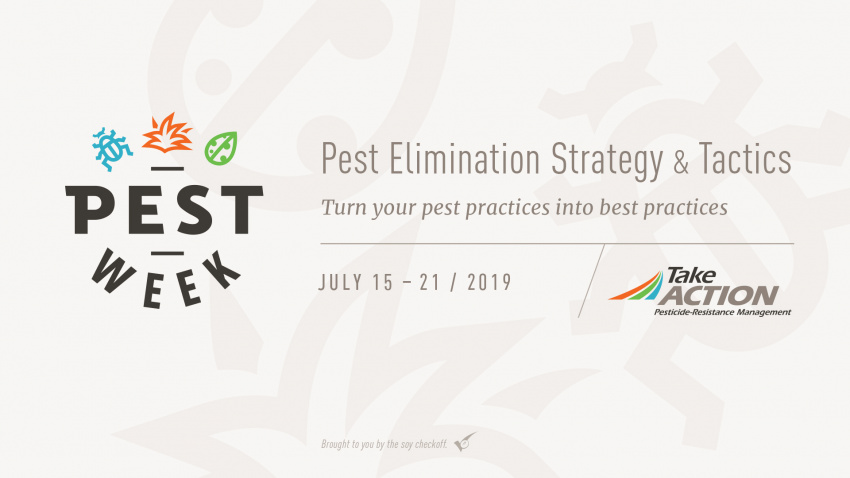United Soybean Board, Take Action Program Focus on Pest Management

PEST Week Focuses on Minimizing Resistance, Promoting Stewardship to Protect Yields
ST. LOUIS (July 18, 2019) — With a difficult season in full swing, the last thing farmers need is pests robbing yield. Sponsored by the industry-wide Take Action program and the United Soybean Board, PEST Week (Pest Elimination Strategies and Tactics) marks a crucial time of year for farmers to scout for weeds, diseases and insects to manage pests responsibly.
“The Take Action program provides farmers with the science-backed resources to help us make the best pest management decisions possible for our farms with the future in mind,” said Bubba Simmons III, USB farmer-leader and soybean farmer from Leland, Mississippi. “PEST Week is a reminder for all farmers to keep product stewardship top of mind this season — even among the challenges — to keep these pest management tools available for years to come.”
Weed competition, disease and insect damage have the potential to cause yield loss from day one, and the repercussions of pesticide resistance could be even more costly. The increase and spread of pesticide resistance threatens farmers’ freedom to operate. The consequences include short and long-term economic challenges, decreasing land values, the uncertain regulatory pathway to access crop protection tools, crop losses and other challenges.
“The industry is at a critical juncture in managing resistance to herbicides, as well as other products,” says Larry Steckel, row crop weed management professor at the University of Tennessee. “New pesticides are being developed and registered for use at a much slower pace than in the past. Because of this, it is becoming more and more important to actively delay the development of resistance to herbicides and other pesticides currently in our toolbox.” Steckel continued, “This is why implementing management strategies — like rotating modes of action, using the full labeled rate and incorporating cultural practices — is crucial.”
Farmers can utilize the full resources of the Take Action program through the website IWillTakeAction.com and the newly updated Take Action app, available in the Apple App Store or Google Play Store. These resources available from Take Action help farmers:
— MANAGE WEEDS: Keep weeds out of fields and fight herbicide resistance with the Ultimate Weed Management Checklist, covering every best management practice to slow herbicide resistance development. Many popular weed management resources have also been updated for 2019, including the Take Action Herbicide Classification Chart, and 13 weed management fact sheets.
— KEEP RECORDS: Herbicide labels differ from state to state, as emphasized with dicamba post-emergence application restrictions. Stay on top of the required recordkeeping paperwork with the Take Action Pesticide Application Record. The fillable PDF can save records electronically or print easily as a one-page document.
— CLASSIFY DISEASES: Take Action also offers several resources related to fungicide management, including the popular Fungicide Classification Chart and Know Your Risk soybean disease evaluation tool.
“Taking the time to understand the products you use and apply them responsibly will not only save you money today by ensuring the most efficient balance of product,” said Simmons, “but also, it will help save all farmers money by keeping these tools available.”
The Take Action program started with industry-wide collaborative discussions about the growing threat of herbicide resistant weeds. Parties included representatives from major agribusiness companies, land-grant university weed scientists and soy, corn, cotton, sorghum and wheat commodity groups. Keep up with the latest updates by following Take Action on Facebook and Twitter or visiting www.IWillTakeAction.com.
USB’s 73 farmer-directors work on behalf of all U.S. soybean farmers to achieve maximum value for their soy checkoff investments. These volunteers invest and leverage checkoff funds in programs and partnerships to drive soybean innovation beyond the bushel and increase preference for U.S. soy. That preference is based on U.S. soybean meal and oil quality and the sustainability of U.S. soybean farmers. As stipulated in the federal Soybean Promotion, Research and Consumer Information Act, the USDA Agricultural Marketing Service has oversight responsibilities for USB and the soy checkoff. For more information on the United Soybean Board, visit www.unitedsoybean.org.
###
© 2019 United Soybean Board. All Rights Reserved. [58577-CB]
